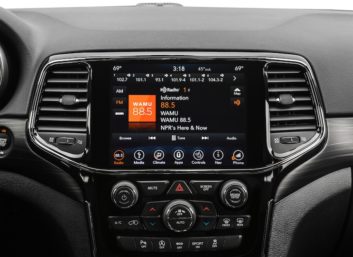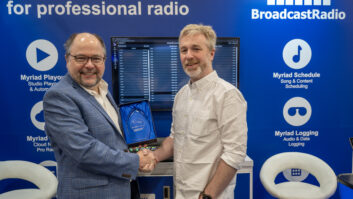Digital radio has made significant progress in recent months and NAB Show session “Digital Radio Roll Out Around the World” will provide attendees with an overview of some of these developments.
Radio World spoke to three of the conference’s speakers, Joan Warner, CEO Commercial Radio Australia; Joe D’Angelo, senior V.P. Radio at Xperi Inc.; and Ole Jorgen Torvmark, CEO at Norsk Radio AS, to gain insight into these advances for DAB+ and HD Radio as well as the issues associated with digital deployment and consumer adoption. DRM is another global standard notable by recent growth (particularly in India), though it was not part of the panel at press time.

TURNING POINT
For Warner, who is also V.P of WorldDAB, the European Union’s implementation of the new European Electronic Communications Code (EECC) marks a turning point for the radio industry. The directive, which took effect in December, requires all new car radios sold in the 27 EU member states to be capable of receiving digital terrestrial radio as well as any FM or AM functionality manufacturers may want to include.
Warner believes this directive “highlights the wider radio industry’s shift toward a digital future, and more importantly, it ensures that millions of car drivers across Europe will have access to the various benefits presented by digital terrestrial radio.”
Torvmark echoes this sentiment, adding that the new EU code “sends a clear signal to all EU countries, car manufacturers and radio listeners that one must take into account a digital future for broadcast radio too.”
Reflecting on his native Norway, the first country to switch off national FM services, Torvmark adds that the biggest news there is about radio listening figures, which had declined after the country’s digital switchover in 2017 but are now back to where they were before the transition.
WorldDAB released a report on April 2 at the Radiodays Europe conference in Lausanne, Switzerland showing how the switchover has impacted Norway’s radio listening. In addition to confirming that the country’s total radio listening has bounced back, the study finds radio’s daily reach there to be at 67 percent of the population compared to 68 percent in 2016. It also reports that listeners are listening for longer (146 minutes per day in 2019 compared to 127 minutes in 2016) and that 86 percent of daily listeners now use DAB+, compared to 55 percent in 2016.
“With the digital switchover behind us, and with the knowledge that we have secured a national, digital, free-to-air backbone for radio distribution, the Norwegian radio industry is focusing on how we can best manage the rest of radio’s distribution, including the user data.” Now, he says, the focus is on “becoming stronger as an industry across borders in the developments for radio taking place with connected cars, voice-controlled devices and IP-distribution.”
In other parts of Europe stats show Germany leading the way, surpassing the United Kingdom, as the main DAB+ consumer receiver market. Both Italy and France now have receiver legislation in place that requires all new receivers to include digital audio capabilities. And in the U.K. DAB today accounts for more than half of all radio listening.
In addition, France’s media regulator Conseil supérieur de l’audiovisuel just published the list of stations that have received a DAB+ license to begin broadcasting nationwide via digital terrestrial radio in 2020. Among recipients are all six of public broadcaster Radio France’s radio channels — France Inter, France Info, France Culture, France Musique, Fip and Mouv’.
OUTSIDE EUROPE
Beyond Europe, Warner points to a number of markets she says WorldDAB is monitoring. These include Vietnam and Thailand, where a 20-month trial with 11 stations is expected to go on air this year in Bangkok.
“Vietnam is also hoping to complete a digital switchover by 2025,” she said. “The first DAB+ trials in the country were conducted in Hanoi in 2013, and more trials are expected this year. The results of the trials in Vietnam will be evaluated in 2020.”

In North America, the HD Radio system continues to move forward with increasing commercial deployment in Mexico, the United States and Canada. In Mexico, D’Angelo counts more than 100 stations that have converted to the digital radio standard, and in Canada, he says, broadcasters also continue to add stations and evaluate the system performance as they move through their regulatory process.
“The strong show of support by broadcasters has helped drive an increase in HD Radio equipped cars,” said D’Angelo. “There are now over 55 million cars on the road with HD Radio technology and over 4,300 HD Radio broadcast programs.” D’Angelo explains that recent activities in South America and Southeast Asia seem to indicate that countries in those regions are ready to begin the transition to digital broadcasting. “For years, the lack of widely available receivers or high price points, have slowed the transition to digital in many markets,” he said.
INCREASING MOMENTUM
“However, in the last decade, the radio industry has benefitted from an ever-increasing number of HD Radio and DAB+ models reflecting a very healthy and vibrant manufacturing and supply chain. In fact, recently the Philippines has broken new ground with the introduction of the first, extremely affordable HD Radio-enabled cell phone.”
But with the changing ways listeners consume audio, how will digital radio remain competitive and/or cooperate with internet-based streaming services?
D’Angelo believes that while broadcast radio operates in a competitive environment, it also has unique advantages over internet-only streaming services. “In many ways, over-the-air radio is the incumbent for audio services and across markets has the benefit of very large/loyal audiences with extremely well established brands and presenters,” he added.
“By investing in all aspects of audio distribution, digital broadcasting, streaming, apps and on-demand, broadcasters are maintaining their connection with their audience and actually growing time spent listening with their programming across distribution platforms.”
He warns though that broadcasters need to embrace all technologies available to them and to create unique programming for each medium as needed. “We are particularly excited about the intersection of broadcast and IP services in the car. At Xperi we are working hard with broadcasters in over 50 countries to bring these together with the DTS Connected Radio ecosystem. This platform will ensure that listeners get the best possible radio experience in the car and the broadcasters benefit from enhanced insights and metrics to power their programming and operations.”
EMBRACE TECHNOLOGY
In Warner’s opinion, for the radio industry, streaming on the internet is a complimentary delivery platform to allow listeners to continue access content across all platforms and is not a replacement for reliable and robust broadcast radio.
“Broadcast radio and in particular DAB+ is free, reliable and doesn’t require access to the internet or electricity, which makes it still the most efficient and effective way to communicate live to a mass audience, particularly in times of emergency. The radio industry worldwide is ensuring radio content is available across all devices with broadcast radio AM, FM, DAB+ as the backbone of the business and where the bulk of listening takes place.”
Warner, Tovmark and D’Angelo agree that radio’s forte is its adaptability and that the medium — still — has a promising future, also thanks to the industry’s commitment on technology and innovation. “Voice activation technology is a perfect example,” says Warner. “As people move away from reading and typing instructions, radio has integrated this new technology with Amazon Alexa to ensure radio is part of the user experience and in Australia, users can simple ask Alexa to play their favorite radio station. Radio continues to evolve and integrate new ways of accessing the content produced by radio broadcasters 24/7,” she concluded.
“Radio is so much more than a jukebox of tracks,” added D’Angelo. “ It remains a highly curated, timely, local medium that delivers an experience, information and entertainment to listeners that cannot be replicated. It is a critical component of any community and can always be counted on. And, just as radio has transitioned from AM to FM to digital it will evolve to ensure that streaming does not kill the radio star.”







